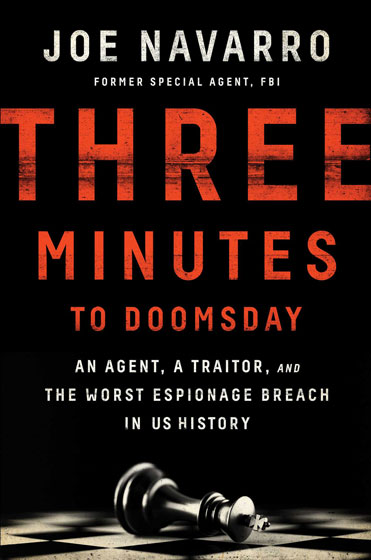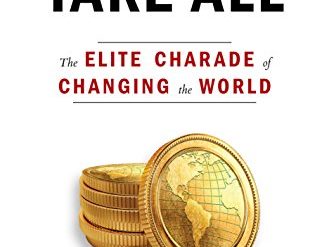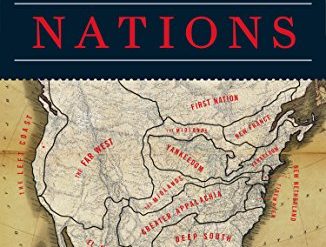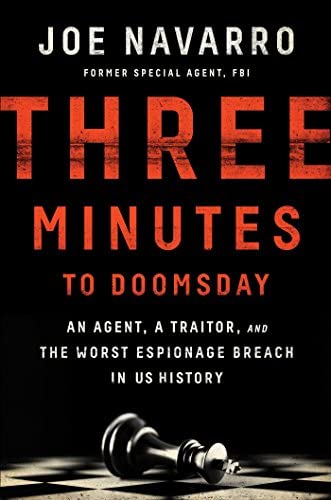
Since the advent of the Second World War more than eighty years ago, spies have stripped the United States of a sobering volume of critical, top-secret information that threatens our security. Name a few names, and students of espionage will immediately recognize the spy scandals they caused. Julius Rosenberg. Jonathan Pollard. Robert Hanssen. Edward Snowden. But two US Army noncommissioned officers in Germany—Clyde Conrad and Roderick Ramsay—appear to have caused an even more serious espionage breach than any of them. Former FBI Special Agent Joe Navarro brings their case into the light of day in his fascinating chronicle of the case he mounted against Rod Ramsay, Three Minutes to Doomsday.
Estimated reading time: 9 minutes
A spy scandal you’ve probably never heard of
Most of the events in Three Minutes to Doomsday took place in the 1980s, culminating in Rod Ramsay’s arrest in 1990. If his name, and Clyde Conrad’s, are unfamiliar to you, it seems likely that the damage they caused was so threatening to the Pentagon and the White House that its true nature was never fully revealed until years later. And to appreciate the seriousness of that threat, you need to understand the military strategy employed by the US and the Soviet Union on the boundary between East and West: the East German border.
Three Minutes to Doomsday: An Agent, a Traitor, and the Worst Espionage Breach in US History by Joe Navarro (2017) 369 pages ★★★★★
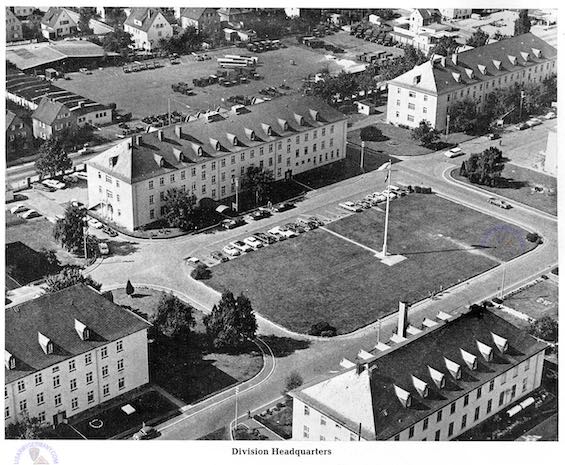
The Cold War flashpoint between East and West
Throughout the Cold War, the American public’s attention focused on the divided city of Berlin, where US and Soviet troops—and spies—confronted each other face-to-face. But for military strategists on both sides of the Iron Curtain the true flashpoint fell to the south and west of the city in the state of Thuringia. There, as you can see on the map below, the broad, low-lying plane known as the Fulda Gap offered the Soviet Union an ideal opening for an invasion of the West spearheaded by an enormous army of tanks.
The vast superiority of the USSR in troop numbers and conventional arms makes the West’s position indefensible there in the absence of nuclear weapons. And the United States had acted accordingly, burying nuclear land mines along the East German border and stationing nuclear-armed missiles within striking distance of Soviet bases. If war had broken out, an exchange of nuclear weapons wouldn’t have been long in coming. Except that Clyde Conrad and Rod Ramsay intervened, fatally threatening the US’s ability to respond.
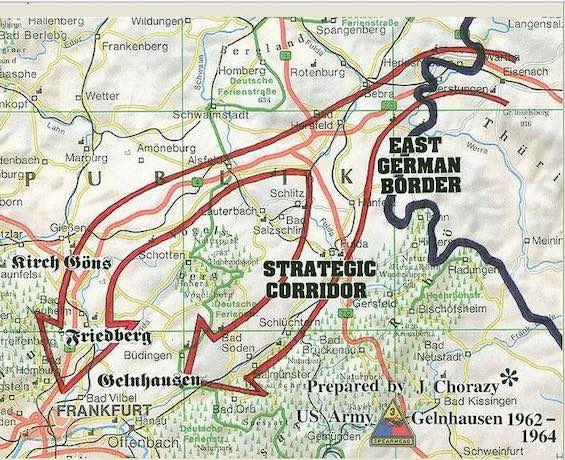
Sharing top-secret US military plans with the Eastern Bloc
For years, Clyde Conrad, and later Rod Ramsay, had daily access to the most secret American war plans at the Army’s 8th US Infantry Division in Bad Kreuznach, Germany. They used the opportunity to steal hundreds, perhaps thousands of pages of highly classified documents and sell them to the Eastern Bloc. They even rented a safe house nearby where investigators later found hundreds of pages of such material strewn about the floor. This was perhaps the most brazen theft of US military secrets ever uncovered—and the most serious by far. Because among the materials they sold to their Hungarian contact was detailed, step-by-step information of how the American military would respond to a Soviet invasion across the East German border.
But the damage was worse than that. In the process of revealing those contingency plans Clyde and Ramsay disclosed details of the elaborate series of codes that commanders would use in the event of war. The codes to release nuclear weapons. Knowing how the system worked, the Soviets could easily have shut it down. And those codes would work not just in Germany but worldwide. In other words, for as long as it took the Pentagon to design and adopt a new coding system governing its nuclear arsenal, the United States and its allies were powerless to respond to attack by the USSR.
A fascinating, fast-paced account of the FBI’s investigation
Author Joe Navarro, a twenty-five-year veteran of the FBI, was in mid-career in the Bureau’s Counter-Intelligence unit when he was ordered to accompany a US Army investigator to interview Rod Ramsay. It was 1988. Ramsay was an after-thought, a known associate of Clyde Conrad, who had been arrested by German authorities on an espionage charge and would soon go to court there. The Army imagined Ramsay could furnish supporting evidence to strengthen the case against Conrad. But in that interview, Navarro observed tics and body language strongly suggesting to him that Ramsay knew much more about Conrad’s spying. He was broadcasting guilt to the author, who was recognized for his deep knowledge of nonverbal communication and body language. And from that point on, Navarro fought tooth and nail with his superiors to mount an investigation of Ramsay himself.
At first, with the grudging approval of his immediate boss, Navarro and a succession of female partners befriended Ramsay, gradually coaxing from him increasing signs that, indeed, he knew a great deal about Conrad’s activities—and had himself been deeply involved. Then higher-ups in Washington began trying to shut Navarro down because the case was to be run out of Washington, and he was stationed in Tampa (where Ramsay lived). When Navarro ignored their orders for months on end, they managed to persuade the Director of the FBI to warn him off for an entire year. But he persisted, and eventually resumed his investigation. The result, in 1990, was Ramsay’s thirty-six-year sentence for treason.
So, why was Rod Ramsay such a threat to US security?
Clyde Conrad’s activities lasted far longer and were far more extensive than Ramsay’s (though he received a sentence of just thirteen years from a German court). Why, then, did the FBI and the Pentagon eventually decide that Ramsay posed the bigger threat? The explanation lies in what Navarro learned about his suspect. According to a knowledgeable source in the Pentagon, Roderick Ramsay had received the second-highest IQ score ever recorded by the US Army. As Navarro learned early on, Ramsay was extremely clever, despite abundant evidence that he had made a mess of his life. But it wasn’t his intelligence alone that was the problem. For Ramsay possessed what, to all appearances, was an eidetic memory, which he demonstrated time and again to Navarro.
At the request of the US National Security Agency, Navarro conducted a test. He asked Ramsay to show what he remembered of specified pages on three representative documents the NSA had selected among those he and Conrad had stolen. Ramsay then proceeded to recite long passages from the multi-page US Army nuclear war plans the NSA had picked, noting the position on each page of the material he’d seen. The NSA confirmed he’d gotten every single word right.
So, Roderick Ramsay was a walking, talking encyclopedia of the most sensitive American military secrets. And since no one could be sure whether all the documents the pair stole had made their way to the Soviet Union, Ramsay could not ever be allowed to fall into the hands of Soviet (soon Russian) intelligence. (He is due to be released from prison in 2026. By that time, presumably, the information will no longer be valid.)
What’s missing from the author’s account
From his first impression to the last, Joe Navarro depicts Rod Ramsay as a pathetic human being, a loser of the most obvious sort. He’s slovenly, gravitates from one dead-end job to another, and lives with his mother in a trailer. He is obviously living in abject poverty, forever short of cash. Yet Ramsay had witnessed the great wealth Clyde Conrad was amassing through his sale of American military secrets to the Eastern Bloc—large boxes full of Krugerrands and other gold coins and envelopes bursting with cash, tens of thousands of dollars at a time.
Yet there is no evidence that Ramsay ever received more than a few hundred dollars for collaborating with Conrad. Much less anything at all for continuing to supply his Hungarian contact with top-secret US Army plans after Conrad had moved on from Bad Kreuznach. Could a man with such demonstrably superior intelligence have been so stupid as not to demand a share of the loot? Or had he somehow stashed a fortune overseas, undiscovered by the FBI? Navarro doesn’t explain. He doesn’t even address those questions.
About the author
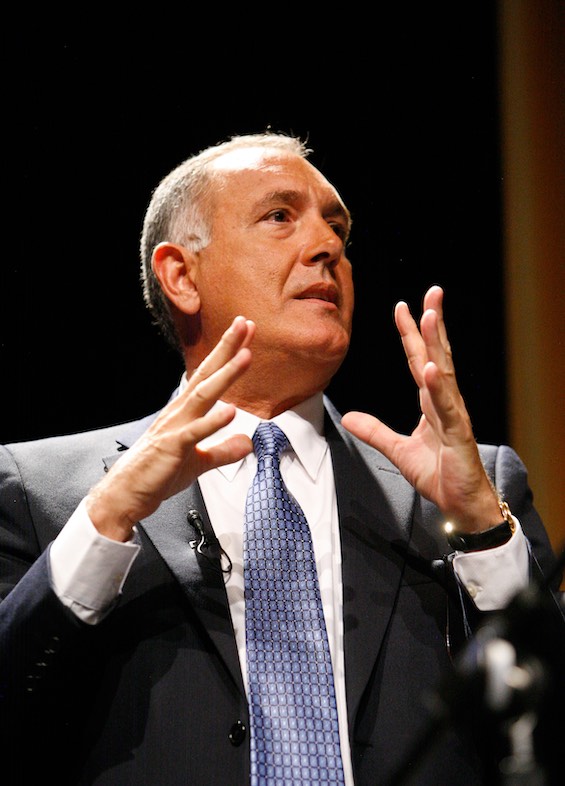
Joe Navarro is a leading expert on nonverbal communication and body language. He is a popular public speaker on the topic and has written thirteen books, one of them an international bestseller on body language. His study of that field was central to his success as an FBI agent, which is evident in his memoir of his biggest case, Three Minutes to Doomsday. Navarro was born in 1953 in Cuba and fled with his family after the Bay of Pigs invasion to Florida. He holds a bachelor’s degree in justice administration from Brigham Young University and a master’s in international relations from Slippery Rock University.
For more reading
You might also enjoy my posts:
- Good nonfiction books about espionage
- 5 top nonfiction books about national security
- The 15 best espionage novels
- The best spy novelists writing today
If you read spy thrillers, consider dipping into the work of these other excellent authors:
- Joseph Kanon’s spy thrillers are superb
- Charles Cumming’s first-rate spy thrillers
- Following Mick Herron’s clever British spies at Slough House
- The spellbinding thrillers of Robert Harris
And you can always find my most popular reviews, and the most recent ones, plus a guide to this whole site, on the Home Page.

